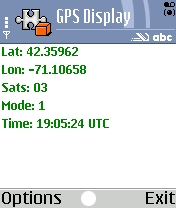One of the nifties things I have on my cell phone is a bluetooth capability: the ability to communicate with other devices nearby at relatively high speeds over a wireless protocol. Bluetooth is a very useful tool for development: I don’t have to worry about USB cables or anything else, and I can talk equally well to my Linux desktop with an abicom BT adapter as I can to my Powerbook with its built-in bluetooth.
One thing that no one has mentioned yet about the new Python release is the Bluetooth console. It took some doing, but I finally got it connected to my Linux desktop, and found an app that will let me connect to the port. Now, I basically have a way to tell my phone what to do over Bluetooth:
[crschmidt@peanut ~]$ sudo cu -l /dev/rfcomm0
Connected.
Python 2.2.2 (#0, Dec 2 2004, 18:12:32)
[GCC 2.9-psion-98r2 (Symbian build 540)] on symbian_s60
Type 'copyright', 'credits' or 'license' for more information.
Type 'commands' to see the commands available in this simple line editor.
>>>
This has sped up my application development significantly: with this in place, I can start to experiment with different code at a rapid rate: without sending almost identical files to the phone several dozen times to test them, nor typing on the 3650’s keypad to enter my code. I just type into a normal tty, and it acts exactly like a local python interpreter.
This is also possible, and documented as such, using TCP/IP over GPRS instead of Bluetooth. However, the speed restrictions of that cause it to be much less practical. It’s like typing into ssh over bluetooth: sure, it’s okay, but you almost never want to do it if you can avoid it.
Here’s what I ended up doing to get it working:
– Get a working bluez install. Bluez is the standard Linux protocol stack, and is built in to most recent kernels.
– Test that you can talk to the phone, using hcitool scan, hcitool info.
– Register an “SP” (serial port) service with sdpd. sdptool add --channel=3 SP
– Ensure that sdpd is running
– Set up an rfcomm port to receive the communications: rfcomm listen /dev/rfcomm0 3
– (On Phone) Open Python, then bt_console.py
– On the computer, you should see:
[crschmidt@peanut ~]$ sudo rfcomm listen /dev/rfcomm0 3
Waiting for connection on channel 3
Connection from 00:60:57:41:86:C2 to /dev/rfcomm0
Press CTRL-C for hangup
– Using taylor-uucp, type cu -l /dev/rfcomm0
– Welcome to the phone!
If you want to test to make sure it’s working, you can do something simple like:
import appuifw
appuifw.note(u'Howdy!', 'info')
from there, refer to the excellent Nokia documentation for more tips and tricks on what you can do. I think this is definitely a great example of what power the distribution has, and I’m surprised that more people haven’t been writing about it. Has anyone besides me (and Nokia employees) gotten this working?
 If you’ve been asking this question, I’ve got software which has an answer for you.
If you’ve been asking this question, I’ve got software which has an answer for you.